The Best is Yet to Be, or Not To Be?

In 2009, the Australian government announced an ambitious project to provide super-fast fiber-based Internet to 93% of the population; in 2013, it revised the plan to reuse existing copper wire; in 2025, many Australians still have no (or slow) Internet. First promise big things, then revise the promise to make them little things, then don’t finish them anyway. This isn’t (we hope) a description of the World Scholar’s Cup curriculum release process, but a pattern of behavior for governments all over the world. Discuss with your team: is it better to underpromise and overdeliver, or vice versa?
Australia has declared its national broadband network (NBN) is “built and fully operational”, ending a saga that stretches back to the mid-2000s. Minister for communications, cyber safety and the arts Paul Fletcher declared the build complete despite admitting that 35,000 premises remain unable to connect to the network. But seeing as that number was over 100,000 in August 2020 and over 11.86 million premises have been wired, he’s happy to say the job’s been done. However Australian outlet itnews points out that over 230,000 premises can't connect at 25Mbps, the speed deemed to represent "broadband" in Australia. So, most places in Australia has broadband and the government feels it has satisfied its responsibilities to the people.
Thus ends a saga that began in the mid-2000s when Australia figured out that ubiquitous broadband access was a good idea. Dominant telco Telstra proposed to build the network and operate as both a wholesaler to rivals and a retailer, at the 2007 election the left-of-centre Australian Labor Party swept to power in part due to its plans to build a fast national broadband network. That promise evolved into a commitment to build a fibre-to-the-premises (FTTP) network. NBN Co, the company charged with building and operating the network, was summoned into existence in April 2009 but struggled to get much done in its early years. By 2013, when a right-of-centre government won power, just over 350,000 premises had been connected. The new government decided that a FTTP build would be too slow and expensive, and launched a new plan called for a “multi-technology mix” that emphasised fibre-to-the-node (FTTN) and use of existing cable TV networks, rather than FTTP everywhere.
Over the years NBN Co. missed deadlines and build costs expanded. A decision to spend billions on a cable network that turned out not to be capable of delivering broadband services was one of many SNAFUs during the build. Nevertheless, it all seemed to have worked out with no detriments for Australia. Its economy outperformed many better-wired rivals throughout the build period and the likes of Netflix were happy to enter the market. The NBN did not slow adoption of streaming video. Nor did it cause widespread problems under the stresses of 2020’s work-from-home wave. Australia has Zoomed as thoroughly as any other nation.
Don’t worry, Australia—you’re not alone. (More on loneliness later.) In Canada, a proposed high-speed rail network had its target speed slashed before being rebranded as a high frequency network. In many developed countries, ambitious projects have gone out of fashion in favor of slow, incremental ones. Check out the mega projects below, as well as those from your own country, then discuss with your team: is this shift in approach justified? How might megaprojects (or their failure) affect the way people perceive progress? And are some countries more consistently successful at these projects?
The train systems in Canada are in need of an upgrade. In the third quarter of 2023, 50% of Via Rail train trips ran on time. Plus, a train trip isn’t much faster than driving; the average train trip between Montreal and Toronto, the most popular one in Canada, takes five hours and eight minutes, while it would take half an hour longer to drive the same distance. To make it worse, the train trip is not much cheaper than
driving while Canada has an extensive rail network, it’s also the only G7 country without a high-speed option—in Japan, China, France, Spain, Italy, and the United States, trains that can reach speeds of over 450 kilometres an hour have been a reality for over a decade.
Canada has, instead, become a world leader in commissioning studies on high-speed rail. Two major corridors are seen as the most likely candidates: Windsor to Quebec City and Calgary to Edmonton. While studies have found that high-speed rail networks in these corridors could boost business and tourism as well as help reduce carbon emissions from cars and airplanes, plans are inevitably always shelved once studies reveal the financial commitments associated with building them. The cost for various high-speed rail projects has been estimated between $6 and $40 billion. (A high-speed rail project in California was supposed to cost $30 billion but quickly blew past initial projections. It could end up costing $130 billion.)
For starters, high-speed rail is logistically impossible in Canada. Via Rail, the Crown corporation that operates Canada’s national passenger infrastructure, owns only about 3% of the tracks its trains run on. Second factor: density. Canadian cities tend to be less densely populated than many of their counterparts in the United States and Europe, so there likely wouldn’t be enough customers to make high-speed rail a profitable investment.
One proposal that is currently on the table is a major investment along the Windsor–Quebec City corridor, which serves the vast majority of Via Rail’s services. But instead of the high speed rail that most European and Asia countries enjoy, they are proposing a more affordable high-frequency rail. According to this proposal, the government would build new tracks along the existing line owned by Via Rail and supply faster electric trains. These would cut service times between stations, increase the number of trains, and significantly reduce delays.
Until last Monday, when engineers began hoisting its two-thousand-ton cutterhead to the surface, Bertha, the world’s largest tunnel-boring machine, was stuck a hundred and twenty feet below the streets of Seattle, too damaged to move far forward and incapable of going in reverse. The machine, which weighs some seven thousand tons and is about as long as a football field, is the centerpiece of a two-billion-dollar project to build a stretch of underground highway two miles long, two lanes wide, and two levels high. But, in December of 2013, after only four months and a thousand feet of digging, Bertha overheated and was shut down. Attempts to fix it set off a cascade of other construction problems, helping to secure the tunnel’s reputation as one of the biggest megaproject fiascoes in history.
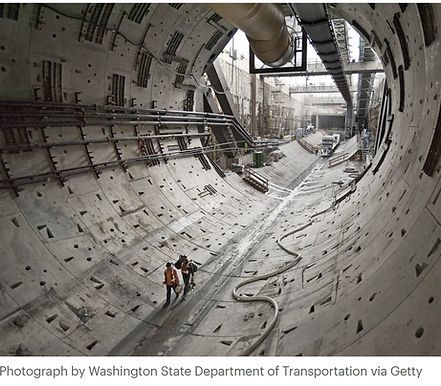
According to Bent Flyvbjerg, a management professor at the University of Oxford’s Saïd Business School, megaprojects have come to constitute 8% of global gross domestic product. China is most responsible for this explosion—according to the scientist Vaclav Smil, the country used more cement between 2011 and 2013 than the United States did during the entire twentieth century—but many nations have contributed.
Some of these projects are properly conceived and implemented—the nearly completed London Crossrail, which includes twenty-six miles of tunnels beneath London, will probably qualify—but they are the exception, according to Flyvbjerg. More common are worthy but poorly executed megaprojects, or megaprojects that never should have been attempted in the first place. The “iron law of megaprojects,” he wrote in a 2014 paper in Project Management Journal, is that they are “over budget, over time, over and over again.” Nine out of ten megaprojects experience cost overruns, and most take much longer to build than expected.
While engineers and almost everyone is enamoured with the idea of a mega project, they often fail because they take so long to complete. They are vulnerable to a kind of entropy, in which even unrelated events can produce huge setbacks. The planners of Pakistan’s Tarbela Dam, for example, projected 7.5% inflation during construction, but the project took eight years longer to complete than expected, by which time inflation had jumped 380% and the total cost of the dam had quadrupled.
Yet megaprojects seem to be practically recession-proof. In fact, the 2008 global economic slowdown likely spurred megaproject construction, since the governments of some countries—among them China, India, and the United States—saw investment in infrastructure as a way to stimulate growth.

For the Seattle project, the mega project went overtime, and overbudget as expected, but they were in too deep and unable to pull out. With Bertha stuck underground, workers spent more than a year digging an 83-foot-wide shaft down to it. Because Seattle’s water table is high, millions of gallons of water had to be pumped out from the site as the shaft was formed. The pumping, in turn, may have caused the surrounding land, in one of the city’s prime tourist areas, to settle by an inch or more; occupants of nearby buildings complain that cracks have begun appearing in their walls. A massive crane, built specifically for the job, completed the two-week-long task of lifting to the surface key parts of the boring machine. Bertha’s problems are not a complete surprise. In 2010, The Stranger, a Seattle alternative weekly, published an article called “What Could Possibly Go Wrong.”
At Oxford, Flyvbjerg, the decision is often as much about social, aesthetic, and even patriotic concerns as about economic ones; the last three skyscrapers to have claimed the title of “world’s tallest,” in Dubai, Taipei, and Kuala Lumpur, were intended, at least in part, to draw attention to their countries’ modernity. The projects suggest the allure of the grand and grandiose, as if their true function were to deliver reassurance that the human arc is upward.

Megaprojects – An Anatomy of Perception
Local People’s Perceptions of Megaprojects: The Case of Suramadu, Indonesia
The following research focused on local people (residents and communities) to gain a deeper understanding of their perceptions of megaprojects, using the Suramadu Bridge in Indonesia as a case study. The research question was: “What are the perceptions of local people regarding the balance between the negative and the positive effects of megaprojects, and what factors affect their perceptions?” To answer this, both a survey and in-depth interviews were carried out. There were two main findings. Firstly, and interestingly, the vast majority of the respondents were supportive of the project, mainly for emotional reasons and because of their cultural background. However, certain groups reported experiencing the negative

externalities of the project, which shows how contested megaprojects are in the eyes of local people. Secondly, an exploratory factor analysis revealed that there are three factors underlying people’s perceptions, namely immaterial benefits, material benefits and specific employment opportunities. The strongest factor turned out to be, again surprisingly, immaterial benefits, implying that people may perceive a different reality caused by the project, involving intangible aspects such as pride and a new identity. We suggest that including people’s perceptions in megaproject studies can contribute to more inclusive megaproject development processes.
Two faces of megaprojects: global ambition and local perception
Megaprojects can bring tangible economic advantages to a city as well as intangible benefits regarding pride and identity. However, these positive impacts often do not extend to local people and communities. The development of megaprojects is encouraged in two ways, namely through cross-national partnerships and through technological innovations that enable big and complex constructions. Fame, aesthetics or the symbolic meanings of iconic megaprojects are stressed as crucial to give identity to a particular area. Beijing, for instance, chose to use modern, high-tech and futuristic architectural designs to brand its megaprojects; the Oresund Bridge between Sweden and Denmark plays a significant role as an iconic symbol of political, economic and cultural integration across national borders; and the Twin Petronas Towers in Malaysia were designed to elevate national pride and identity through a symbolic and material role in postcolonial nation-building.
Finally, perceptions are usually captured at a single moment, whereas they usually continue to change over time and space. The development of megaprojects always takes a long time, and each stage of the process (planning, construction and usage) involves dynamics and uncertainties that affect people’s perceptions. During the process, the net benefit of project investments may turn from negative to positive, or vice versa.
It is important the local communities stay well informed throughout the process for mega projects to gain support. Two interesting findings. Analysing people’s perceptions could be a way to focus more on the social implications at the local community level and fill a gap in the literature. At the same time, the outcomes can also be explained as a case of politicising megaprojects, in which a positive perception is created despite negative local externalities. Therefore, for further research, we recommend exploring how cultural aspects might influence people’s perception of megaprojects, especially in relation to a social-structure model of society.
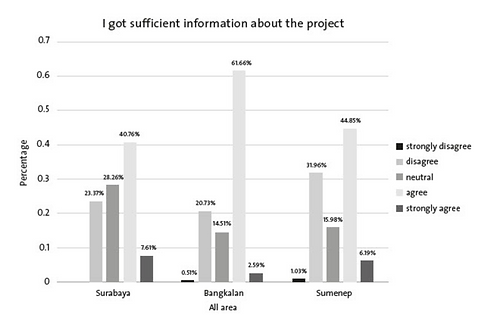
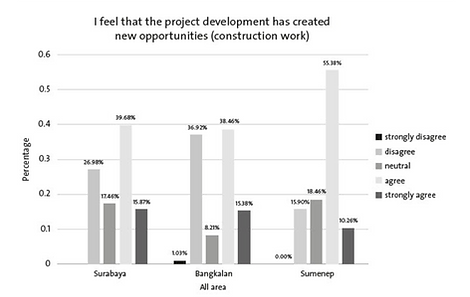
The Big Dig was developed in response to traffic congestion on Boston's historically tangled streets, which were laid out centuries before the advent of the automobile. The Big Dig was a megaproject in Boston that rerouted the then elevated Central Artery of Interstate 93 that cut across Boston into the O'Neill Tunnel and built the Ted Williams Tunnel to extend Interstate 90 to Logan International Airport.
The Big Dig was the most expensive highway project in the United States, and was plagued by cost overruns, delays, leaks, design flaws, accusations of poor execution and use of substandard materials, criminal charges and arrests, and the death of one motorist. The project was originally scheduled to be completed in 1998 at an estimated cost of $2.8 billion, US$7.4 billion adjusted for inflation as of 2020. The project was completed in December 2007 at a cost of over $8.08 billion in 1982 dollars, $21.5 billion adjusted for inflation, a cost overrun of about 190%.
Additionally, obstacles to the project included political and financial difficulties, protest from historical neighborhoods. The
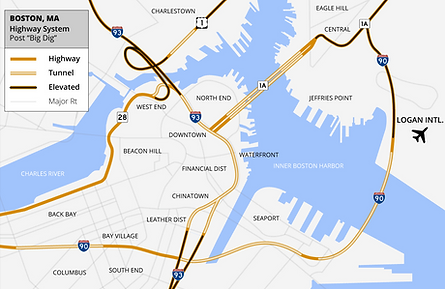
project also had to adjust two major subway lines and innumerable number of pipes. Tunnel workers encountered many unexpected geological and archaeological barriers, ranging from glacial debris to foundations of buried houses and a number of sunken ships lying within the reclaimed land. Reworking such a busy corridor without seriously restricting traffic flow required a number of state-of-the-art construction techniques. Because the old elevated highway, which remained in operation throughout the construction process, rested on pylons located throughout the designated dig area, engineers first utilized slurry wall techniques to create 120-foot-deep (37 m) concrete walls upon which the highway could rest. These concrete walls also stabilized the sides of the site, preventing cave-ins during the continued excavation process.
Nevertheless, it has brought a great deal of economic value and efficiency for the city of Boston. The result was a 62% reduction in vehicle hours of travel on I-93, the airport tunnels, and the connection from Storrow Drive, from an average 38,200 hours per day before construction (1994–1995) to 14,800 hours per day in 2004–2005, after the project was largely complete.The savings for travelers was estimated at $166 million annually in the same 2004–2005 time frame. Travel times on the Central Artery northbound during the afternoon peak hour were reduced 85.6%. Therefore, I would sum it up as expensive, painful, but necessary for the city of Boston.
Interestingly, Boston is usually the day trip for the scholars of the Tournament of Champions!
The Channel Tunnel (French: Tunnel sous la Manche), sometimes referred to by the portmanteau Chunnel, is a 50.46-kilometre (31.35-mile) undersea railway tunnel, opened in 1994, that connects Folkestone (Kent, England) with Coquelles (Pas-de-Calais, France) beneath the English Channel at the Strait of Dover. It is the only fixed link between the island of Great Britain and the European mainland. At its lowest point, the tunnel is 75 metres (246 feet) below the sea bed and 115 metres (377 feet) below sea level. At 37.9 kilometres (23.5 miles), it has the longest underwater section of any tunnel in the world and is the third-longest railway tunnel in the world. The tunnel is owned and operated by Getlink, formerly Groupe Eurotunnel. Plans to build a cross-Channel tunnel were proposed as early as 1802, but British political and media criticism motivated by fears of compromising national security had disrupted attempts to build one. The eventual successful project, organised by Eurotunnel cost £5.5 billion in 1985. It was at the time the most expensive construction project ever proposed. The cost finally amounted to £4.65 billion (equivalent to £11.7 billion in 2023).

California High-Speed Rail (CAHSR) is a publicly funded high-speed rail system being developed in California by the California High-Speed Rail Authority. Phase 1, about 494 miles (795 km) long, is planned to run from San Francisco to Los Angeles and Anaheim via the Central Valley, and is partially funded and under construction. A proposed Phase 2 would extend the system north to Sacramento and south to San Diego, for a total of 776 miles (1,249 km). The project was authorized by a 2008 statewide ballot to connect the state's major urban areas and reduce intercity travel times. Phase 1 targets a nonstop travel time of 2 hours and 40 minutes from San Francisco to Los Angeles (wow! This is usually a 45 minute flight or 7 hours drive!), compared to about nine hours on the existing Amtrak San Joaquins. California legislative overseers do not expect the 2 hr 40 min target will be achieved. Due to limited funding, the project is being built in sections. Supporters of the project state that it would alleviate air traffic and highway congestion, reduce pollution and greenhouse gas emissions, and provide economic benefits by linking the state's inland regions to coastal cities.
The 2008 California voter approval required the project to be financed with matching funds from other sources, including private and federal. The government of Japan offered long-term, low-interest financing if California employed Shinkansen bullet-train technology. The project is now financed mainly by the state of California, supplemented by federal grants. By the end of 2023, the share of committed funding borne by the state was 76%. The Authority has only one source of persistent cash flow: a fixed share of revenue from California cap-and-trade (Carbon emission trading) auctions set to expire in 2030. Operation is expected to start 2031-2033 on the IOS (Merced to Bakersfield). The project faced many technical and funding challenges. Funding wise, buying property for the tracks was seriously delayed; this might be one of the reasons why the line runs through Central Valley instead of heavily populated cities. Another issue was finding the right type of trains; Elon Musk even proposed hyperloop, but that was technologically unproven. To save costs some sections of the tracks are planned to operate on a blended system with slower trains and high-speed trains sharing one line.

Sejong was founded in 2007 as the new planned capital of South Korea to ease congestion in South Korea's current capital and largest city, Seoul, and encourage investment in the country's central region. Since 2012, the government of South Korea has relocated numerous ministries and agencies to Sejong, but many still reside in other cities, primarily Seoul, where the National Assembly and many important government bodies remain. The construction of the city is expected to be completed in 2030, at which time 500,000 people are expected to live there.
Sejong was named in honor of King Sejong the Great, the fourth king of the Joseon Dynasty and creator of the Korean alphabet, Hangul. It is the brainchild of then-President Roh Moo-hyun back in 2003. By 2019, there was disagreement among experts as to whether Sejong has "lived up to expectations". Sejong uses its new development to market itself as an alternative to Seoul, offering luxury living at a fraction of the cost. It boasts shiny state-of-the-art condominiums, ample public green space and smart and sustainable city tech, like automated trash collection and zero-waste food disposal, electric car charging and sharing stations, solar-powered buildings, interactive digital signage, closed-circuit television security and fine dust emergency alerts. It has sparked criticism that the new city is not only too lackluster to draw residents away from Seoul, but also difficult to access and poorly designed.
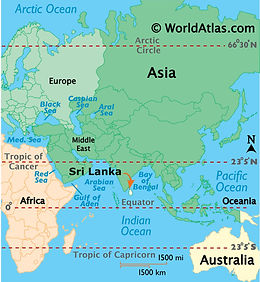

Hambantota the main city in Hambantota District, Southern Province, Sri Lanka. This underdeveloped area was hit hard by the 2004 Indian Ocean tsunami and is undergoing a number of major development projects including the construction of a new sea port and international airport finished in 2013. These projects and others such as Hambantota Cricket Stadium are said to form part of the

government's plan to transform Hambantota into the second major urban hub of Sri Lanka, away from Colombo.
The port, which was intended to become a major hub in global shipping routes, came to represent the financial mismanagement and corruption of Sri Lankan Pres. Mahinda Rajapaksa and his family, who were removed from power by popular revolt in 2022. Hambantota port was financed by Chinese commercial lenders and later leased to Chinese merchants to pay off debt. Critics of China’s Belt and Road Initiative (BRI) have cited the port as an example of predatory lending by China, although accusations of “debt-trap diplomacy” do not neatly fit the case of Hambantota port.
Neom is an arcology (portmanteau for archeology and ecology) and planned city being built by Saudi Arabia in Tabuk Province. Launched in 2017 by crown prince Mohammad bin Salman. The name "Neom" is a blend. The first three letters are the Ancient Greek prefix neo meaning "new". The fourth letter, M, is the first letter of Crown Prince Mohammed bin Salman's name, as well as the first letter of the Arabic word for "future." Multiple regions are planned, including a floating industrial complex, global trade hub, tourist resorts, and a linear city powered by renewable energy sources. Saudi Arabia claimed that NEOM would create around 460,000 jobs and add an estimated $48 billion to the country's GDP. Thousands of people have been forcibly moved to make way for the project and villages have been razed. Much of the city is hoped to be completed by 2039, though some experts have expressed skepticism about the ambitions of the megaproject. The project's estimated costs exceed $8.8 trillion (more than 25 times the annual Saudi budget). To fund this megaproject, on 29 January 2019, the Saudi government announced that it had established a closed joint-stock company named Neom. The company, which is solely dedicated to developing the economic zone of Neom. By July 2022, only two buildings had been constructed, and most of the project area remained bare desert.


Innovative or extravagant? The city boasts some very spectacular architecture/urban development. Oxagon (originally named Neom Industrial City) was announced as a floating industrial complex in the shape of an octagon. Trojena project was launched, which will potentially be the first major outdoor skiing destination in the Arabian Peninsula. In January 2024, Neom announced Aquellum, a "subterranean digitalized community of the future" that will "invert architectural principles to integrate with nature". Most stunning is The Line - a conceptual linear smart city in Saudi Arabia in Neom, Tabuk Province, housed in a single building, that is designed to have no cars, streets or carbon emissions.
The Khazar Islands, also known as Caspian Islands, is a stalled development of artificial islands 25 km (16 mi) south of Baku, Azerbaijan consisting of 41 islands extending 3,000 hectares (30 km2; 7,400 acres; 12 sq mi) into the Caspian Sea. Despite elaborate plans to build a complete city with schools, bridges, shopping centers galore, the plans stalled. Construction on Khazar Islands began in March 2011 and substantial building works were achieved during Azerbaijan's economic boom. In August 2014, the main beach area was opened with a fanfare with many sky-scraper buildings already part constructed. However, the project's gigantic scale and overly ambitious design became more obvious in 2015 as the oil price crashed.
The president of the controlling Avesta Group of Companies, Ibrahim Ibrahimov, reportedly had the original idea in a flash while flying between Baku and Dubai. Post his arrest for debts and release, even though he has claimed to return to this project, there has been no signs of construction.
The Three Gorges Dam is a megaproject in China that boasts Chinese construction and development while raising concerns over ecological damage and cultural displacement. It is a hydroelectric gravity dam that spans the Yangtze River near Sandouping in Hubei province, central China, downstream of the Three Gorges. It is the world's largest power station by installed capacity (22,500 MW). The dam's body was completed in 2006; the power plant became fully operational in 2012. The dam enhances the Yangtze River's shipping capacity and provides flood
control, helping to protect millions of people from severe flooding on the Yangtze Plain. Additionally, its hydroelectric power generation has helped fuel China's economic growth. As a result, the Chinese government considers the project a source of national pride and a major social and economic success. Estimates of the number of people displaced by the dam's construction range from 1.13 million to around 1.4 million, and inundated ancient and culturally significant sites. The area which would fill with water behind the dam included locations with significant cultural history. The State Council over the course of several years, have authorized salvage efforts and archaeologists excavated 723 sites and conducted surface archaeology recovery missions at an additional 346 sites. Archaeologists recovered 200,000 artifacts of which 13,000 were considered as particularly historically or culturally notable.
In operation, the dam has caused some ecological changes, including an increased risk of landslides. Undoubtedly an amazing feat, there are also continued concerns about its structural security and it is a big case study as China continues to build mega dams along other rivers that might affect entire regions and neighboring countries.

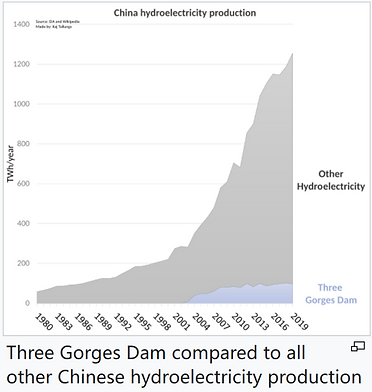
The Hong Kong–Zhuhai–Macau Bridge (HZMB) is a 55-kilometre (34 mi) bridge–tunnel system consisting of a series of three cable-stayed bridges, an undersea tunnel, and four artificial islands. It is both the longest sea crossing and the longest open-sea fixed link in the world. The HZM Bridge was designed to last for 120 years and cost ¥127 billion (US$18.8 billion) to build. The cost of constructing the Main Bridge was estimated

at ¥51.1 billion (US$7.56 billion) funded by bank loans and shared among the governments of mainland China, Hong Kong and Macau. Originally set to be opened to traffic in late 2016, the structure was completed on 6 February 2018.
Hopewell Holdings founder and then-managing director Gordon Wu proposed the concept of a bridge-tunnel linking Mainland China, British Hong Kong and Portuguese Macau in the 1980s. Wu stated that he got the idea in 1983 from the Chesapeake Bay Bridge–Tunnel. In 1988 Wu pitched the concept to Guangdong and Beijing
officials. Later government organization and working groups were formed to finance, construct and supervise the entire project, led by China's Central Government.
The project's construction period was filed with some controversy over worker conditions, death tolls and quality concerns for the sea walls etc. Nevertheless, unlike many other mega structures, it was completely relatively on time. The HZMB links three major cities—Hong Kong, Zhuhai, and Macau—which are geographically close but separated by water. With the bridge in place, travelling time between Zhuhai and Hong Kong was cut down from about 4 hours to 30 minutes on the road. On 31 January 2025, the Zhuhai port of the bridge reported a new record of 156,000 passenger trips in a single day, a new record since the bridge's opening.
The New Eurasian Land Bridge, also called the Second or New Eurasian Continental Bridge, is the southern counterpart to the Eurasian Land Bridge and runs through China and Central Asia with possible plans for expansion into South and West Asia. The Eurasian Land Bridge system is important as an overland rail link between China and Europe, with transit between the two via Central Asia and Russia. In the light of the Russian invasion of Ukraine, China halted further investments in the part of the bridge that was planned to go through Russia. Overall this iron land bridge is a crucial part of China's One Belt One Road Initiative, aimed at enhancing connectivity and trade between Asia and Europe. The route links China's coastal cities to various European destinations, facilitating international trade and economic cooperation.
Due to a break-of-gauge between standard gauge used in China and the Russian gauge used in the former Soviet Union countries, containers must be physically transferred from Chinese to Kazakh railway cars at Dostyk and Khorgos on the Chinese–Kazakh border and again at the Belarus–Poland border where the standard gauge used in western Europe begins. This is done with truck-mounted cranes.
Kazakhstan's President Nursultan Nazarbayev urged Eurasian and Chinese leaders at the 18th Shanghai Cooperation Organisation to construct the Eurasian high-speed railway (EHSRW) following a Beijing-Astana-Moscow-Berlin route. On 7 November 2019 the first Chinese freight train through the Marmaray tunnel to Europe ran, from Xi'an using a Chinese locomotive. This demonstrated a China-to-Turkey transportation time reduced from a month to 12 days, and is part of the Iron Silk Road.

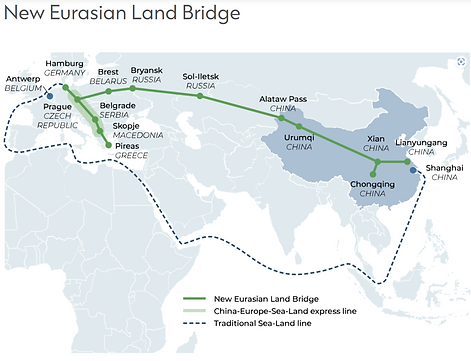

Sometimes social distancing is the problem. In 2023, the World Health Organization declared loneliness a pressing global health threat. Explore how this concern varies around the world, then discuss with your team: do you agree that there is a “loneliness epidemic”—and, if so, how can it be treated?
The World Health Organization has launched an international commission on loneliness, which can be as bad for people’s health as smoking 15 cigarettes a day. It comes after the Covid-19 pandemic halted economic and social activity, increasing levels of loneliness, but also amid a new awareness of the importance of the issue. While loneliness is often seen as a problem for developed countries, Dr Vivek Murthy, US surgeon general, said the rates of one in four older people experiencing social isolation are similar in all regions of the world.

In older adults, loneliness is associated with a 50% increased risk of developing dementia and a 30% increased risk of incident coronary artery disease or stroke. But it also blights the lives of young people. Between 5% and 15% of adolescents are lonely, according to figures that are likely to be underestimates. In Africa, 12.7% adolescents experience loneliness compared to 5.3% in Europe. Young people experiencing loneliness at school are more likely to drop out of university. It can also lead to poorer economic outcomes; feeling disconnected and unsupported in a job can lead to poorer job satisfaction and performance.
Past studies in the industrialized world have suggested loneliness is on the rise, but without historical data on the issue, it's hard to say how present-day numbers compare over time or across geographical regions. "It's a commonly held belief that around 1 in 12 people experience loneliness at a level that can lead to serious health problems, however, the source of such data are unclear and researchers have never established how widespread loneliness is on a global scale," says epidemiologist Melody Ding from the University of Sydney.
Global loneliness estimates were mostly available for adolescents, and findings among 77 nations suggest the issue can range from 9.2% in South-East Asia to 14.4% in the Eastern Mediterranean region. Unfortunately, for adults, there was only enough data for the meta analysis to hone in on the European region. In this corner of the world, the authors once again found geographical differences. Northern European nations had the lowest rates of loneliness, with only 2.9% of young adults experiencing the negative emotion and 2.7% of middle-aged adults feeling the same. Older adults, over the age of 60, experienced lonesomeness at a higher rate of 5.3%.
Eastern European countries, on the other hand, showed more signs of loneliness than anywhere else in Europe. Young adults in Eastern Europe reported feelings of loneliness at a rate of 7.5%, while middle aged adults reported feelings of loneliness at a rate of 9.6 percent. Older adults in this part of Europe, meanwhile, were the loneliest of the lot, coming in at a worrisome 21.3%. The data can't tell us why Eastern Europe appears to have a more lonely populace overall, but one study included in the review suggests the effect is due to worse health outcomes, healthcare services, and social support.
Some countries have tried tackling the problem with technology—and none more so than Japan. Explore efforts to “fix” loneliness in Japan and elsewhere, then discuss with your team: are they the sorts of solutions that more societies should adopt? What technologies would you design to achieve the same aims?
As traditional family-based communities fracture, robot companions are becoming much more common. In Japan innovative technology such as Paro, a robotic seal, is providing social interaction to elders at Tokyo’s Silver Wing care facility. Loneliness is a big issue in Japan, which has the oldest population in the world. Statistics focusing on loneliness in Japan are scarce, but an estimated 6.24 million Japanese people over 65, and a total of 18.4 million adults ― twice as many as 30 years ago ― live alone. By 2040, 40% of the country’s inhabitants will be solo dwellers. The consequence of this has been a rise in kodokushi ― people dying alone

and remaining undiscovered for long periods of time ― especially among younger generations. One estimate is that there are 30,000 of these lonely deaths a year, but companies that clean apartments when kodokushi are discovered say the number could be two or three times higher.
In her book, Sekai Ichi Kodoku na Nihon no Ojisan (Japan’s Old Men are the World’s Loneliest), psychologist Junko Okamoto dubs Japan the “loneliness superpower. Society is not doing enough to address loneliness and people don’t want to admit how unhappy they are.” Additionally, many workers face punishing hours, fueling the phenomenon of karōshi, or death by overwork. At the less extreme end of the spectrum, grueling work schedules leave people with little time to find partners and have children.
Sony’s Aibo robot dogs, for example, re-launched by maker Sony after being retired in 2006, inspire such an emotional bond with their owners that some hold funerals when the robotic pets stop working. Tech giant Softbank Robotics produces the Pepper robot, a humanoid designed to provide companionship, which some have taken to integrating into their family as substitute children or grandchildren.
A whole industry also has sprung up to provide company to younger customers, primarily men, who aren’t having human relationships. (A 2013 study found that 30% of Japanese men in their 20s and 30s had never dated.) Gatebox has developed the anime-inspired VR-companion, tailored toward younger men who, due to long work hours or other reasons, prefer the company of a virtual partner.



The country wanted robots to help care for the elderly. It has been in development for years, yet devices such as Robear (left), which was developed in Japan in 2015, have yet to be normalized in care facilities or private homes.
Japan has been developing robots to care for older people for over two decades, with public and private investment accelerating markedly in the
2010s. By 2018, the national government alone had spent well in excess of $300 million funding research and development for such devices. In Japan, birth rates are below replacement levels, the population has started to shrink, and though in 2000 there were about four working-age adults for every person over 65, by 2050 the two groups will be near parity. The number of older people requiring care is increasing rapidly, as is the cost of caring for them. At the same time, the already large shortage of care workers is expected to get much worse over the next decade.
A growing body of evidence is finding that robots tend to end up creating more work for caregivers. Even though robots are all the hype in the media in Japan, they don’t really feature in any major aspect of most people’s daily lives in Japan, including elder care. A major national survey of over 9,000 elder-care institutions in Japan showed that in 2019, only about 10% reported having introduced any care robot, while a 2021 study found that out of a sample of 444 people who provided home care, only 2% had experience with a care robot. There is some evidence to suggest that when robots are purchased, they often end up being used for only a short time before being locked away in a cupboard. According to researcher James Wrights who observed robots in action at a nursing home in Japan featuring: Hug, a lifting robot; Paro, a robotic seal; and Pepper, a humanoid robot. He discovered that they were abandoned quickly because they were cumbersome, created social emotional issues (refuse to eat meat), and were boring. Since the research ended, all of these products have been retired and people realize that AI could solve a lot, but some jobs are still better handled by humans.
In 2021, the UN Development Programme found that living conditions in 90% of the world's countries had declined for the second year in a row—possibly contributing to declining birth rates. Discuss with your team: is this decline irreversible or will the world’s population begin to boom again? Should we want it to?
Published in 2022, this article claims. "The UN's Human Development Index has declined globally for two years in a row for the first time in 32 years amid the combined effects of climate change, the coronavirus pandemic and the war in Ukraine."
The index has declined globally for two years in a row since the first time it was calculated 32 years ago. The UNDP's report said that this erased "the gains of the past five years." UNDP chief Achim Steiner said that even at the height of the last global recession which broke out in 2007, the index declined in only around one in ten countries. The combined effects of climate change, the war in Ukraine and the COVID-19 pandemic have created an "uncertainty complex" exerting downward pressure on global living standards, the report said.

According to the index, Switzerland is the most highly developed country in the world. Norway and Iceland come at a close second and third place. The United States took first place in 1990 when the index was first calculated, but has since slipped to 21st place. The least developed country listed in the ranking is South Sudan, followed by Chad and Niger. While development may be overall positive, it certainly is not fair for the people in some developing countries facing conflicts and refugees and even those in the lower class in wealthy countries.
The report, titled Barely Hanging On: The Cost-of-Living Crisis in NSW explores the experiences across a range of issues such as housing, employment, income and financial hardship. The key finding of the report is that once perceived as a temporary economic anomaly, The Cost-of-Living Crisis has evolved into a persistent, structural feature of contemporary society or the new normal. This shift from a crisis to the new normal is intricately linked with broader systemic challenges that are both local and global in nature. The new term is "meta-crisis" in which many dilemmas ranging from climate change to AI are interconnected on a local and global level. The report summarizes 6 main contributors to the meta-crisis.

-
Economic Disparities: The rich stay unharmed while the poor struggle in poverty.
-
Debt Levels: High levels of personal and national debt create vulnerabilities
-
Automation and Job Displacement: While technology can increase productivity, it also risks displacing workers, particularly in low-skilled sectors.
-
Digital Divide: Access to technology varies widely, impacting economic opportunities.
-
Environmental Costs: Climate change has very tangible economic impacts, from damage to infrastructure due to extreme weather events to increased insurance costs and resource scarcity.
-
Transition Costs: Shifting to sustainable practices and renewable energy requires significant investment.
I have always been afraid of the population boom. Reading this article gave me some new perspective. I wonder given today's social issues of loneliness and cost of living crisis, maybe the younger generation is pondering halting procreation and focusing on sustainability and quality of life. This article doesn't take into account the development of AI. Will AI exacerbate the population issue or resolve it?
-
Falling fertility rates are propelling major economies toward population collapse in this century. 2/3 of humanity lives in countries with fertility is below the replacement rate of 2.1 children per family. By 2100, populations in some major economies will fall by 20 to 50%, based on UN projections.
-
Age structures are inverting—from pyramids to obelisks—as the number of older people grows and the number of younger people shrinks. The first wave of this demographic shift is hitting advanced economies and China, where the share of people of working age will fall to 59% in 2050, from 67% today. Later waves will engulf younger regions within one or two generations. Sub-Saharan Africa is the only exception. China was famous for the one-child policy and has since reversed it to a three child recommendation.
-
Consumers and workers will be older and increasingly in the developing world. Seniors will account for 25% of global consumption by 2050, double their share in 1997. Developing countries will provide a growing share of global labor supply and of consumption, making their productivity and prosperity vital for global growth.
-
The current economic model cannot support existing income and retirement norms—something must give. In first wave countries across advanced economies and China, GDP per capita growth could slow by 0.4% annually on average from 2023 to 2050, and up to 0.8% in some countries, unless productivity growth increases by two to four times or people work 1 to 5 hours more per week. Retirement systems might need to channel as much as 50% of labor income to fund a 1.5-time increase in the gap between the aggregate consumption and income of seniors. Later wave countries, take note.
-
Societies enter uncharted waters. Absent action, younger people will inherit lower economic growth and shoulder the cost of more retirees, while the traditional flow of wealth between generations erodes. Long-standing work practices and the social contract must change. More fundamentally, countries will need to raise fertility rates to avert depopulation—a societal shift without precedent in modern history.
-

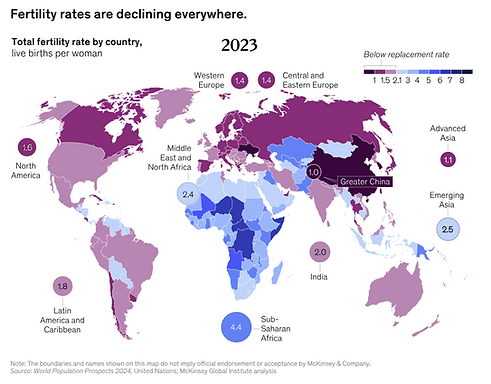

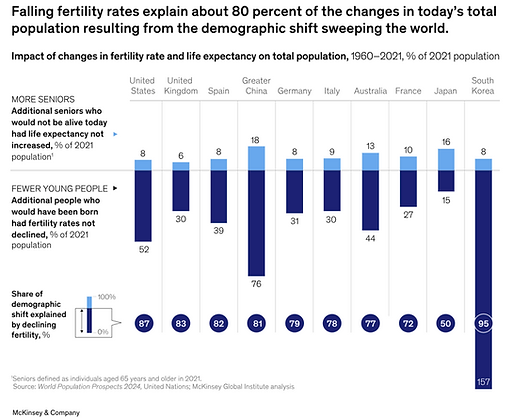
During the Covid pandemic, podcasts exploded in popularity. Their hosts (or at least their subtly-enhanced voices) became many people’s closest friends in a solitary time. Discuss with your team: are podcasts meaningfully different from old-fashioned radio broadcasts in their impact on society, and will their impact continue? In other words, how dated will this bullet seem, ten years from now?)
Written in 2021 during the height of the pandemic, the article claims that the pandemic has seen audio shows fill a hole in our lives, providing companionship that is increasingly difficult to distinguish from the real thing. The pandemic has, no doubt, expedited the podcaster-friend trend. After a brief dip in listener numbers during the first lockdown (something attributed to the change in people’s daily routines, particularly the absence of a commute), audience figures leapt up again – in December, BBC Sounds reported a 21% increase in podcast listening over the year. The number of podcasts also ballooned, filling voids in the

professional lives of the hosts and the social lives of the listeners, and in some cases replacing both. There were periods during lockdown where I was hearing more from certain podcasters than anyone else on Earth – even the people I was sharing a home with. The term for this kind of social relationship is called "parasocial interaction," a term coined by sociologists Donald Horton and Richard Wohl in 1956. Obviously, they did not have podcasts in mind, but everything about the form seems perfectly pitched for such a relationship to blossom.
Podcasts are intimate, with no in-the-room audience to remind you of your own distance. They can also be very long, and very long-running, which means masses of information about the podcaster can be communicated and a network of in-jokes and callbacks established. They are often collaborative, fuelled in part by listener correspondence. There are a lot of them and the bar to entry is far lower than for other forms of media. This makes podcaster feel closer and more personal than other forms of information/entertainment.
The pandemic also meant that most friendships were conducted exclusively through technology, blurring the lines between podcasters and acquaintances even further. “We’re all starved of information,” says 32-year-old Steph, who counts the Nobody Panic hosts Tessa Coates and Stevie Martin among her podcast pals. “A story you’ve heard [from a friend] and a story you’ve heard via a podcast are coming in via the same medium, which is a disembodied voice on your phone. In a lot of ways, one isn’t any more real than the other.” While podcasters make for easy, convenient friendship, there is also something missing: the messiness and opportunity to talk about myself.
Speaking of bullets, the man who eventually assassinated American President James Garfield, Charles Guiteau, was certain they had a close personal connection (which, of course, Garfield never knew about.) The Internet has driven a surge in these one-sided “parasocial” relationships. Algorithms on these platforms are designed to boost engagement and view time, even if the content is harmful or raises false hopes. Explore how social media also affects the health of adults and seniors, then discuss with your team: who should be held responsible when an algorithm promotes harmful content? Could you design an algorithm to craft a healthier, happier society—and would it be successful?
Crazy fans/or not assassinating famous celebrities or politicians because they believe they have a relationships or obsession with theme seem all too surreal yet very real. Reminds me of the song "Billie Jean" by Michael Jackson in which an obsessions and "crazy" fan believed that Michael is the father of her son. Unfortunately, modern day celebrities too many to count also suffer from this kind of strange fan situation, and some of escalated into actual attempts on their lives.

Charles Julius Guiteau was an American man who assassinated James A. Garfield, the 20th president of the United States, in 1881. A failed lawyer, Guiteau believed that he had played a major role in Garfield's election victory, for which he should have been rewarded with a consulship. Guiteau felt frustrated and offended by the Garfield administration's rejections of his applications to serve in Vienna or Paris to such a degree that he decided to kill Garfield and shot him at the Baltimore and Potomac Railroad Station in Washington, D.C. Garfield died 79 days later from infections related to the wounds. In January 1882, Guiteau was sentenced to death for the crime and was hanged five months later.
In the last 50 years, regardless of geographic location, gender, race, or ethnicity, rates of loneliness have doubled in the United States. A big reason is the ubiquitous of social media and how it has become entangled with almost every part of our lives. A survey exploring social media patterns explained that it was found that individuals who spent more time on social media every day felt lonelier than those who spent less time engaged in social media. Additionally, those who spent more time on social media in a given week felt more isolated than those who checked their social media less. An increase in social media use has been associated with increased distractibility and sleep disturbances. In summary, social media creates anxiety as we have an urge to feel constantly connected and a fear of missing out on something, but this reliance of social media actually decreases our social interaction with real people face to face. Additionally, seemingly perfect and glamorized profiles on social media may add to anxiety and creates a sense of low self-esteem.
Another side effect of so much social media is cyberbullying. A survey of 5,600 youth between the ages of 12 and 17 showed that 34% admitted to being cyberbullied, and 17% clarified that it had occurred within the last month. Of those who had been bullied, 64% shared that it affected their ability to learn and feel safe at school. 12% of the students admitted to cyberbullying another person. Finally, cyberbullying is not always interpersonal. While the research is still new in this area, it is worthwhile to consider that some individuals who engage in this self-inflicted digital pain may use it as a desperate attempt to connect with others who will join in on the bullying process. Bottom line, too much social media online is unhealthy. Drop the phone, computer, or iPad, stop gaming. Instead go out with your friends or have a discussion with your WSC buddies.
Nina Vasan, clinical assistant professor of psychiatry at Stanford and founder and executive director at Brainstorm: The Stanford Lab for Mental Health Innovation, and Sara Johansen, resident psychiatrist at Stanford and director of clinical innovation at Stanford Brainstorm, are working with platforms such as Pinterest and TikTok to design and implement more empathic user experiences.
What makes social media so addictive? What keeps us hooked on social media isn’t just the “pleasure rush of the like,” says Johansen, “it’s the intermittent absence of the like that keeps us engaged.”
When does it become harmful? When we spend too much time scrolling, we may be susceptible to social comparison. When presented with the curated feeds of other people, we are vulnerable to “frequent and extreme upward social comparison.”
What are we doing now? Social media platforms now use AI to monitor bullying and if user search up harmful content related to abuse or self-harm, hotline and support information will appear. Social media is not all bad. For example, Brainstorm’s recent work with Pinterest led to Pinterest Compassionate Search, which offers free therapeutic exercises on the platform in response to depression-related search terms.

A new study reveals similar associations between depression and social-media use for their parents and grandparents too. In a survey conducted by Roy Perlis, the Dozoretz Professor of Psychiatry at Massachusetts General Hospital and Harvard Medical School, and John Della Volpe, director of polling at the Harvard Kennedy School’s Institute of Politics, they find that seniors are also the victims of social media related mental health issues.
Findings about mental health and social-media use can be tricky to interpret. Most studies can’t prove that using Facebook or Instagram causes depression.
It can't be certain if the depression was caused by or a product of the someone feeling down. Perhaps social media is associated with depression but does not cause it, ie social-media users get their news in a format that offers less balanced coverage or promotes “doomscrolling,” dampening mood in the process. Maybe “they are using social media instead of seeing other people,” Perlis offers, “or they’re using social media because they don’t have social supports in the real world.”
The survey finds some intriguing insights between particular social-media platforms and depression in certain age groups. For example, Facebook use was associated with depression among people younger than 35, but not for those over 35. In the over-35 group, TikTok and Snapchat were connected to depression symptoms.
Perlis speculates that “what seems to be the case in kids is probably true in adults: constantly looking at images of people who appear to be happier than you, and more successful than you, who generally seem to have a better life than you, certainly doesn’t make most people feel better.” A barrage of negative images isn’t likely to help either. Social media is like “drinking from a firehose,” he says, in contrast with older forms of media, which offer smaller doses of potentially harmful images.
Because of one law, the internet has no legal duty of care when it comes to hate speech. Just take a look at what happened in Myanmar.
The historical context begins on New Years Day in 2017 in Istanbul when a terrorist opened gun fire at a nightclub killing 39 people and injuring 69 people under the banner of terrorist group ISIS. One of the victims was Jordanian citizen Nawras Alassaf and his family sued social platforms, Facebook, Twitter and Google, which owns Youtube because they believe that social media algorithms for recommendations helped in recruiting radical agents. Their court case was called Twitter versus Taamneh and they argued that tech companies profit by utilizing algorithms but they also have a responsibility to the outcomes. If social media platforms are being used to promote terrorist content, does their failure to intervene constitute aiding and abetting?


The Supreme Courts decision was no, insisting that without ample evidence that tech companies offered explicit treatment to the terrorist, failure to remove harmful content does not constitute "substantial assistance." Similar case Gonzales versus Google about the 2015 ISIS attack in Paris also has the same decision. The decision was based on a landmark act called Section 230 of the Communications Decency Act from 1996 in which, "No provider or user of an interactive computer service shall be treated as the publisher or speaker of any information provided by another information content provider." When the law passed, the internet has less than 10 million users, compared to 5 billion today. Personalization and a focus on English content may be a cause of neglect for internet giants to remove potentially dangerous content from other parts of the world.
One notable incident is the Meta's role in the 2017 Rohingya Genocide in Myanmar. Supposedly Facebook algorithms amplified hateful content and even the UN said it played a "determining role" in fueling ethnic strife that caused the mass violence against the Muslims in Myanmar's Rakhine State. This example is especially alarming. Myanmar was once one of the least digitally connected countries in the world. Facebook found mass popularity after the deregulation of their telecommunications industry which was formerly state owned. In fact, Facebook launched a Free Basic Program that provided a Facebook centric version of the Internet to the local people. Myanmar's military and extremist Buddhist groups posted fake news such as false rape accusations that sparked violence. Experts say that Facebook exacerbated hateful comments and this was one of the factors that led to the Rohingya Genocide that caused the death of 25,000 and 700,000 refugee. Later Amnesty International and UN both filed reports of this situation. With over 15 million users in Myanmar, yet Facebook only operated a four Burmese speaking content moderators, meaning post of the hateful content was not filtered. In one case, a post in Burmese that read: “Kill all the kalars that you see in Myanmar; none of them should be left alive,” was translated to “I shouldn’t have a rainbow in Myanmar,” by Facebook’s English translation algorithm. Additionally, Facebook's algorithms insulated these hateful comments, preventing them from public scorn. Some of the most followed individuals in Myanmar were military generals posting anti-Rohingya content. Six Myanmar civil service organizations penned a letter to Facebook CEO Mark Zuckerberg in which Facebook messaging service sent false warnings of “jihad" attacks to Buddhist communities while at the same time sending Muslim communities of anti-Muslim protest. Facebook has since taken some action and increased investment in Myanmar for moderation and banning military entities on Facebook and Instagram.
The case of Myanmar is especially distressing because it falls in a legal loophole. The Rohingya people have been denied citizenship and currently are refugees in neighboring countries of Bangladesh and Malaysia. Also, Myanmar is not a signatory of the Rome Statute against genocides and such under the International Criminal Court (ICC), which does not actually try corporations. The closest legal entity with any sort of protection is the US, but US companies are not held responsible due to Section 230. But, is changing Section 230 the answer? Changing it might result in an over-correction and sanitize the Internet to become a place without opinions. This seems like a great debate topic.
How often do you pick up your phone to check a fact or answer a question during a meal with friends or family? Can you imagine living in a world where things just—stay mysterious, and where you have no idea what is happening a thousand miles away? Researchers have found that the oversaturation of news, especially of negative stories, leads to constant stress and a skewed worldview, especially when they contain violent images and videos. Discuss with your team: to protect people’s mental health, should the government (or others) limit the amount of information we can consume?
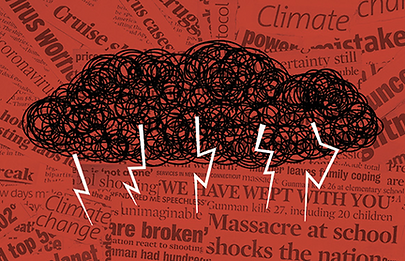
Psychologists are seeing an increase in news-related stress; installing a few key media guardrails can help. “They may have just read about an animal on the verge of extinction or the latest update on the melting polar ice caps,” said Grant, who is also president of American Psychology Association’s Division 46 (Society for Media Psychology and Technology). They may not even recognize at first that the news has affected their mood. But, he said, “They’re perseverating on it—it’s bothering them.”
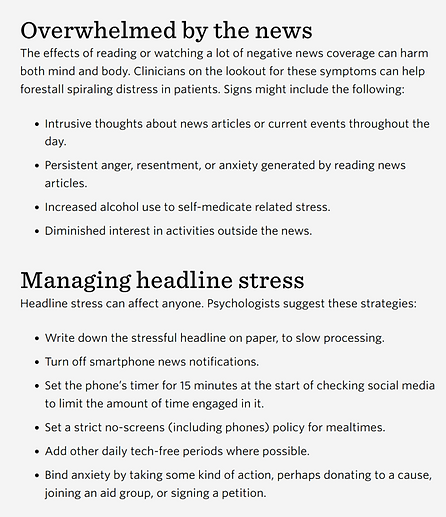
Reports show that people who are seeingk the news headlines more often are prone to news anxiety. Psychologists advise taking the news in appropriate sizes, and taking action to feel empowerment. “What sort of values does the patient want to strive for, and then what can they actually do to achieve, to work toward those values,” he said. “Scrolling more on Twitter is not going to be in service of that value, or of any value that one might have.” As doomscrolling become more and more prevalent, people need to consciously beware of how social media impacts their mood, unconsciously. In the past, psychologists assumed these negative symptoms were related to events such as 9/11, however, they are noticing that it has become a chronic issue for some patients. Steven Stosny, PhD, who specializes in treating people suffering from anger and resentment, first noticed a surge in those symptoms, along with anxiety, leading into the 2016 election (Trump versus Clinton). In this media environment, Stosny described the smartphone as a sort of drug delivery system, incessantly delivering news and
other information. Research has demonstrated that a phone alert spurs a small release of dopamine, a powerful motivator, he said. “Your phone buzzes, and you are going to reach for it, if you are hanging by one arm on a cliff.”
Nevertheless, it is also not advisable to stop cold turkey. It is better to take small steps to limit social media induced anxiety, such as turning off notification, limit social media scrolling to 15 minutes. Have conversations with people instead of staying glued to the phone. The article also warns that it is also not a good idea to block negative news from children, who have active imaginations that might overreact and imagine the worse that could happen. In the example of a forest fire, instead of reading constantly about its damages, it is better to list out people who could help or turn to. Be apart of advocacy group that can help the situation will give you the feeling of comfort and empowerment that is essential to overcome the negative influences of doomscrolling.
On 15 April 2013, as hundreds of runners streaked past the finish line at the annual Boston Marathon, two bombs exploded, ten seconds apart. Three people were killed that day, including an eight-year-old boy. Hundreds were injured. Sixteen people lost limbs.
As the world mourned the tragedy, news organisations embarked upon months – years, if you count the trial – of graphic coverage. Footage of the moment of detonation, and the ensuing confusion and smoke, were broadcast repeatedly. Newspapers were strewn with haunting images: blood-spattered streets, grieving spectators and visibly shaken victims whose clothing had been torn from their bodies.
Researcher Alison Holman, who studied the effects of a terrorist attack on mental health, discovered that another group had been even more badly shaken: those who had not seen the explosion in person, but had consumed six or more hours of news coverage per day in the week afterwards. Bizarrely, knowing someone who had been injured or died, or having been in the vicinity as the bombs went off, were not as predictive of high acute stress.


With Covid-19 and the pandemic, the whole world was glued to screen consuming all the news about fatalities and outbreak. Even back in 2018, the average American spent around eleven hours every day looking at screens, where information about global events is hard to escape. Many of us even take our primary news-delivery devices, our mobile phones, to bed.
One potential reason the news affects us so much is the so-called “negativity bias”, a well-known psychological quirk which means we pay more attention to all the worst things happening around us. Somewhere in our evolution, we were internally trained to be greater affected by negative impacts, where fear outweighs opportunity. Better be safe than have more. Also, negative news is more attention-grabbing and holds the viewers longer. One website – the City Reporter, based in Russia – decided to report exclusively good news for a day in 2014, they lost two-thirds of their readership. Many industries are thus affected, from the stock market to global tourism. The news has a far greater impact than what we presume.
One way this is thought to happen is through “framing effects”, in which the way something – such as a fact or choice – is presented affects the way you think about it. For example, a drug which is “95% effective” in treating a disease sounds more appealing than one which “fails 5% of the time”. Using different phrasing and frequency, the news can change the public's opinion on a wide variety of issues from health, economics, national security and environmental impacts. Interestingly, it goes both ways, the public is more aware if something is on the news, and the most something is on the news, it might get more attention and funding. The article gives the example of cancer research and funding.
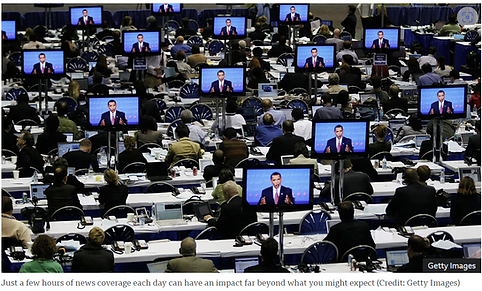
Stress related to news is often directly linked to natural disasters and events. After the 2014 Ebola crisis, the 9/11 attacks, the 2001 anthrax attacks, and the 2008 Sichuan Earthquake, for example, the more news coverage a person was exposed to, the more likely they were to develop symptoms such as stress, anxiety and PTSD. Yet, even though it seems we are so easily affect, oddly when you ask people how they actually feel after these “life-changing” events, it turns out they often have far less of an impact on our emotions than we expect. A classic 1978 study
compared the happiness of those who had recently had their lives transformed by winning the lottery or becoming paralysed. The lottery winners were no less happy than the controls and only slightly happier than the accident victims. Physically, a 2012 study found that women – but mysteriously, not men – who had been primed by reading negative news stories tended to become more stressed by other challenges, leading to a spike in their levels of the stress hormone, cortisol. Negative news also has the power to raise a person’s heart rate. Studies are showing that these small spikes can lead to long-lasting health issues.
Even when they’re reporting on already-traumatic incidents, news channels often can’t resist adding an extra frisson of tension. After the Boston Marathon bombings, coverage often appeared alongside urgent, sensationalising text such as “new details” and “brand new images of marathon bombs”.
-
Social media platforms are facing pressure to protect users from harmful content, particularly violent media.
-
Research suggests that children and adults can be traumatized by viewing excessively violent online content.
-
Awareness about potentially violent material may help us better educate, cope, and filter this toxic content.
With all the crazy things people post online, parents are rightly concerned about what kids are seeing online. In addition to pornography, another potentially toxic category is violent "traumatic media"—extremely graphic and violent videos from crime scenes, wars, and disasters. Such images can be harmful to children and vulnerable adults. Following 9/11, research showed that exposure to traumatic media may induce a kind of sympathetic post-traumatic stress disorder (PTSD) in some viewers. One potential safeguard will be age checks and warnings that ask viewers to voluntarily "click to see hidden content." A broader concern is that, as millions view traumatic media, it will ultimately desensitize us to horrific scenes of crime, disaster, and war.









